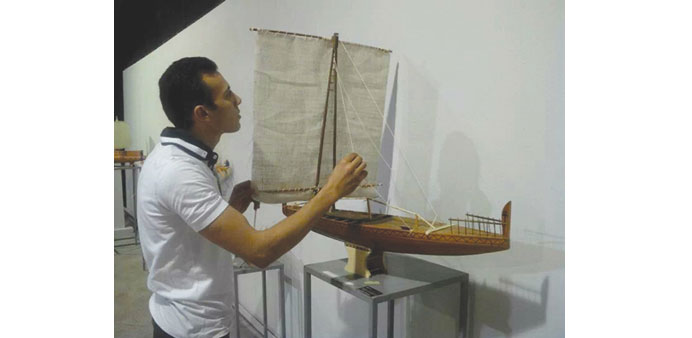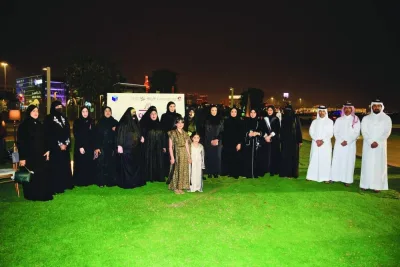TALENTED: Ahmed Farouq with a Pharaonic boat he made, at his exhibition.
Ahmed Farouq, a wood carver, is one of his kind in
Doha. By Anand Holla
On the last evening of Eid celebrations, a stream of people keeps flitting about inside the Souq Waqif Art Centre. At the end of the row of artists plunged into various stages of hand-drawn portraits, Ahmed Farouq, a wood carver, sits behind a table full of wood art.
The assortment of carved wood handicrafts is hard to ignore – lamps, mirrors, miniature models of house, cars, airplanes, bicycles, guitar-shaped key stand, and of course names carved on little wooden planks. In a corner, there’s an adorable portrait carved out of a thin wooden sheet of Egyptian star Soad Hosny, famously known as the “Cinderella of Egyptian cinema.” One look at this piece is enough advertisement for Farouq’s skills.
The 27-year-old artist loves to hand-carve pretty much any design he fancies. Before he moved to Doha to work as a wood carver at the Souq Waqif Art Centre a year ago, Farouq worked in Egypt for a decade – for most years, as a carpenter. “Four years back, I realised I wanted to pursue wood art,” he recalls. On a visit to the Egyptian Museum in Cairo, Farouq was so taken in by the intricately designed Pharaonic boats on display that he was ready to give into the artist that he felt bubbling within.
“I learnt everything I could about Pharaonic boats and other wood art I wanted to make. I scoured Google and YouTube to learn wood carving techniques and soon began creating pieces,” says Farouq, who worked as an artist at the Egyptian Museum from 2008 to 2011. “My father couldn’t believe I had become an artist,” he says and smiles.
The self-taught wood carver believes in recycling. That’s why he frequently visits Ain Khalid, where he scrounges for blocks of wood scattered around old, razed down buildings. He then cleans those using chemicals to give them a rebirth. “The new crop of wood isn’t of as good quality as those,” he says, “I care about wood as it’s a precious resource.”
While he regularly gets special orders from customers who ask him for everything from wood-carved verses of the Holy Qur’an to dynamic wood pieces for kids, Farouq too experiments with ideas, comfortable with wherever they take him. “I had made a waist-high model of a dinosaur too,” he says, “But I am really excited about making the first airplane model, you know the one the Wright Brothers invented.”
It’s not just creative satisfaction that Farouq has to make peace with. Business is doing well too, and especially on Thursdays and Fridays. “I decide the price of a piece depending on the time it took,” he says, “and also effort.” Farouq also knows that he is a rare find. “It will be hard for you to find good woodcarving artists here in Qatar,” he says.
While carving a name on a wooden block takes him an hour, creating a lamp design takes him around four. Moreover, working outdoors – artists usually sit right outside the Centre – can be tough to concentrate at times. “People just randomly come and point at a handicraft and ask – How do you do that,” he says, shaking his head, half-smiling. But Farouq is ever-ready to oblige them.
“Some customers demand that they want it done right away. But art can’t be summoned under pressure, you know,” he says. Yet some customers have turned out to be a blessing too. “One lady from Saudi Arabia wanted me to make a nicely carved hand mirror, while a guy from Qatar wanted me to make a lamp with names of him and his wife etched on it. I continue exploring these ideas that I get from people,” he says, pointing at the other mirrors and lamps he now has made.
Farouq’s dream exhibition is to create a series of Pharaonic boats and Qatari boats and juxtapose them so as to stimulate conversations around their similarities and differences. “I would love to be part of a larger cultural dialogue,” he says.
“When I look at beautiful works of art, I wonder how artists who never went to art schools could create them. Then I tell myself, I too can learn more on my own. I feel life is a big school, much bigger than any art school. It teaches you a lot if you are willing to learn,” says Farouq.



